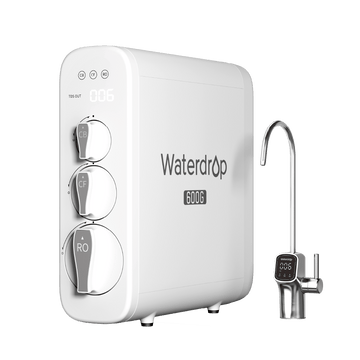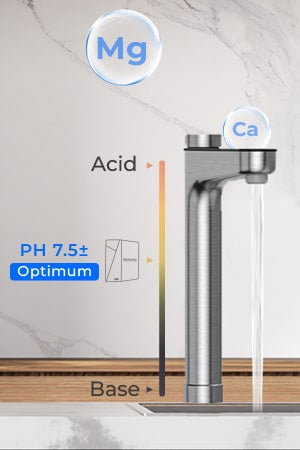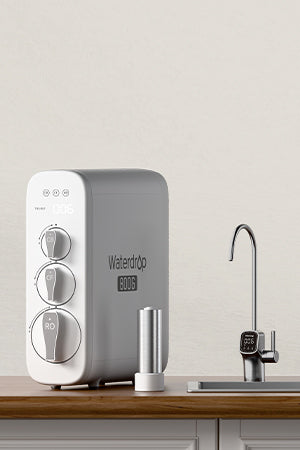Les systèmes d'osmose inverse (OI) sont un choix populaire auprès de nombreux foyers en raison de leur capacité à fournir une eau propre, saine et savoureuse. Ces systèmes sont particulièrement appréciés pour filtrer les impuretés telles que les métaux lourds, les pesticides et autres contaminants. Cependant, comme tout système de filtration d'eau, l'entretien de votre système d'OI est essentiel pour une performance et une longévité optimales.
Ce guide présente des étapes pratiques pour entretenir efficacement votre système d'osmose inverse. En suivant ces conseils, vous garantirez un fonctionnement optimal de votre système et une eau de haute qualité pour les années à venir.
Pourquoi l’entretien est-il important pour votre système RO ?
Entretien régulier de
système d'osmose inverse présente les avantages suivants.
- Assure la qualité de l'eau. Des filtres et membranes propres améliorent la pureté de l'eau en éliminant efficacement les contaminants.
- Prolonge la durée de vie du système. Un entretien approprié réduit l'usure des composants clés, vous permettant ainsi de réaliser des économies à long terme.
- Prévient les obstructions et les dysfonctionnements. Des filtres sales ou surutilisés peuvent bloquer le débit d'eau et réduire l'efficacité. Des composants propres améliorent le débit et la filtration de l'eau.
- Économies d'énergie. Un système bien entretenu consomme moins d'énergie pour traiter l'eau, réduisant ainsi les factures d'électricité et les frais de réparation.
Comprendre les composants de votre système d'osmose inverse
Pour entretenir efficacement votre système RO, il est essentiel de comprendre ses éléments clés.
- Filtre à sédiments. Bloque la saleté, la rouille et les particules plus grosses.
- Filtre à charbon. Élimine le chlore et les composés organiques nocifs pour la membrane d'osmose inverse.
- Membrane d'osmose inverse. Filtre les contaminants microscopiques comme les métaux lourds et les bactéries.
- Filtre post-charbon. Améliore le goût et l'odeur de l'eau purifiée.
- Réservoir de stockage. Contient de l'eau filtrée pour un accès facile.
- Robinet. Distribue de l'eau purifiée.
Comment entretenir votre système d'osmose inverse
Les systèmes d'osmose inverse nécessitent un entretien régulier pour fonctionner de manière optimale. Voici quelques étapes essentielles pour entretenir votre système d'osmose inverse.
Remplacez les filtres régulièrement
Les filtres doivent être remplacés périodiquement pour que votre système fonctionne efficacement.
- Filtre à sédiments. Remplacez-le tous les mois pour éviter le colmatage et protéger la membrane d'osmose inverse.
- Filtre à charbon. Remplacez-le tous les mois pour maintenir l'efficacité de l'élimination du chlore.
- Filtre post-charbon. Remplacez-le chaque année pour garantir une eau toujours fraîche.
Le fait de sauter les remplacements peut entraîner une réduction de l’efficacité de la filtration, une baisse de la qualité de l’eau et des dommages potentiels au système.
Désinfectez le système chaque année
La désinfection empêche l’accumulation de bactéries et maintient le système hygiénique.Si vous utilisez un système RO avec un réservoir, voici quelques étapes à suivre.
- Coupez l’alimentation en eau et videz le réservoir de stockage.
- Utilisez un désinfectant de qualité alimentaire ou un mélange d’eau et d’eau de Javel non parfumée pour nettoyer le réservoir et la tuyauterie.
- Rincez abondamment pour éliminer tout résidu d’agent nettoyant avant de redémarrer le système.
Vérifiez les fuites
Les fuites peuvent compromettre les performances du système et gaspiller des eaux. Voici quelques points à vérifier régulièrement :
- Raccords et tubes pour fissures ou desserrage.
- Le robinet pour les gouttes.
- Le réservoir de stockage présente des signes d'usure inhabituels.
Si vous détectez des fuites, resserrez les connexions ou remplacez les pièces endommagées.
Purger le système
De nombreux systèmes d'osmose inverse incluent un mécanisme de rinçage automatique ou manuel. Un rinçage régulier permet de nettoyer la membrane, d'améliorer l'efficacité du système et de prolonger la durée de vie des filtres et de la membrane.
Dépannage des problèmes courants liés à l'osmose inverse
| Problème | Cause | Solution |
| Débit d'eau réduit | Filtres ou membranes obstrués | Remplacer les filtres ou la membrane RO. |
| Goût d'eau désagréable | Filtre à charbon périmé | Remplacez le filtre post-charbon. |
| Fuites persistantes | Connexions ou tubes desserrés | Resserrez les raccords ou remplacez les tubes. |
| Fonctionnement bruyant | Air emprisonné dans le système | Rincez le système et assurez-vous que les connexions sont étanches. |
Considérations environnementales
Les systèmes d'osmose inverse produisent des eaux usées lors de la filtration. Voici comment harmoniser l'entretien de votre système d'osmose inverse avec des pratiques respectueuses de l'environnement.
- Recyclez les eaux usées. Utilisez-les pour le ménage ou le jardinage, si nécessaire.
- Jetez les filtres de manière responsable. Consultez les directives locales pour une élimination ou un recyclage approprié des filtres usagés.
- Optez pour des systèmes à haut rendement. Des modèles comme le Waterdrop X minimisent la production d'eaux usées.
Améliorez votre système —— Le système RO Waterdrop X12
Le système RO sans réservoir de 1 200 GPD offre un accès instantané à l'eau pure grâce à son débit impressionnant et à sa filtration avancée en 11 étapes.
SGS Testé et amélioré avec la garantie LED, il réduit efficacement les TDS, le fluorure et les métaux lourds, garantissant ainsi la sécurité et la santé de chaque goutte. Des minéraux alcalins infusés comme le calcium et le magnésium équilibrent le pH à un niveau optimal de 7,5±, favorisant le bien-être et rehaussant les saveurs des boissons et des préparations culinaires.
Conçu pour une efficacité moderne, ce système comprend un robinet numérique intelligent avec un débit d'eau précis, un suivi en temps réel des TDS et des indicateurs de durée de vie du filtre. Sa conception sans réservoir permet un gain de place et favorise l'éco-durabilité grâce à un rapport eau pure/eau vidangée de 3:1, le meilleur du marché. Associé à un filtre durable de 24 mois, il offre des performances à long terme avec un entretien minimal : idéal pour les familles en quête de santé, de commodité et de durabilité.
Quand appeler un professionnel
Bien que l’entretien de routine puisse souvent être effectué à domicile, certaines situations nécessitent l’aide d’un professionnel :
- Faible pression d'eau persistante ou fuites malgré le dépannage.
- Bruits inhabituels provenant du système.
- Remplacement de pièces complexes, telles que la membrane RO.
Consultez l'équipe d'assistance de votre fabricant ou engagez un technicien certifié pour garantir une manipulation appropriée.
Derniers mots
L'entretien de votre système d'osmose inverse est essentiel non seulement pour profiter d'une eau propre et saine, mais aussi pour optimiser son efficacité et sa durée de vie. En suivant ces conseils d'entretien (changement des filtres à intervalles réguliers, désinfection du système et vérification des fuites), vous garantirez le fonctionnement optimal de votre système d'osmose inverse. Privilégiez un entretien régulier pour profiter des bienfaits d'une eau propre tout en préservant l'environnement.




























































